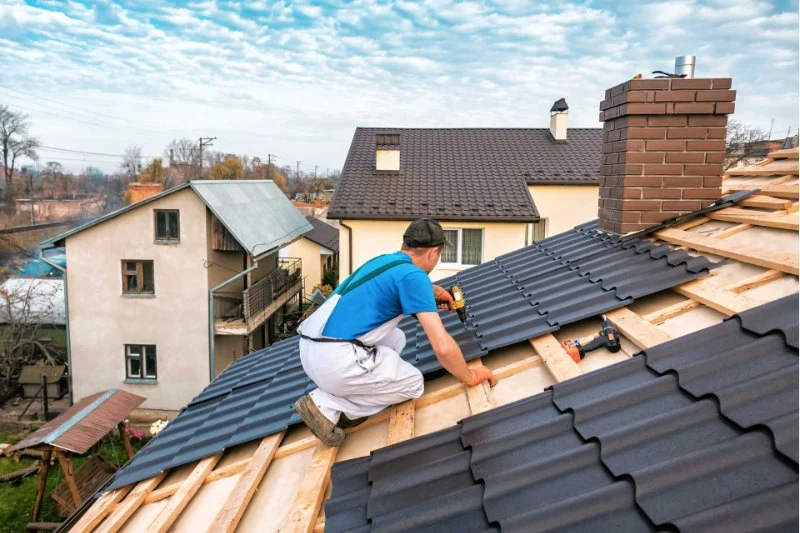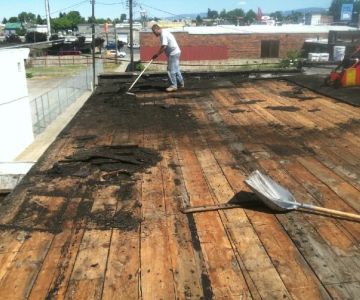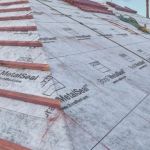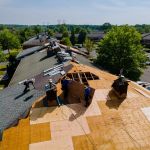
- 1- What is a Roofing Project Phasing Plan?
- 2- Why Phasing is Important for Large Properties
- 3- Key Components of a Roofing Project Phasing Plan
- 4- How to Develop a Roofing Project Phasing Plan
- 5- Challenges and Solutions in Phasing Large Roofing Projects
1- What is a Roofing Project Phasing Plan?
A roofing project phasing plan is a strategic approach that breaks down a large roofing project into smaller, manageable phases. It’s designed to ensure that the roof replacement or repair process is executed efficiently and without unnecessary disruptions. Phasing helps prioritize the most critical areas, minimize risks, and maintain safety while working on a large property.
For large properties such as commercial buildings, apartment complexes, or institutional structures, phasing is crucial. These types of projects often involve complex logistics, numerous workers, and long timelines. Phasing ensures that the entire roofing process can be carried out smoothly without affecting the daily operations of the building or its occupants.

Morrissey Family Roofing
East BridgewaterPlymouth CountyMassachusetts
30 Brown's Ln, East Bridgewater, MA 02333, USA
2- Why Phasing is Important for Large Properties
Large properties present unique challenges when it comes to roof replacement or repairs. The size and complexity of these buildings mean that doing everything at once is not feasible or practical. Phasing a roofing project helps address several key factors:
- Minimizing Disruption: With large buildings, it's important to limit disruption to the building’s operations, especially if it's an office, hospital, or hotel. Phasing allows the project to be completed in sections, so only specific areas are affected at a time.
- Safety and Compliance: Roofing work on large properties requires careful attention to safety protocols, especially when the work involves high-rise buildings. Phasing the project can ensure that safety measures are followed, preventing accidents.
- Weather Conditions: The weather can often affect roofing projects, particularly for larger areas. Phasing allows contractors to work around weather delays and ensures that the roof is repaired in the most weather-appropriate order.
- Cost Control: Phasing allows for better budget management, as costs can be broken down into more manageable portions. It allows contractors and property owners to better track the project’s expenses and ensure financial transparency.
3- Key Components of a Roofing Project Phasing Plan
Developing a successful phasing plan involves careful planning and coordination. Here are the main components that should be considered in any roofing project phasing plan:
- Site Assessment: Before any work begins, a thorough site assessment must be conducted to identify the condition of the roof and prioritize areas that need immediate attention.
- Timeline and Deadlines: Setting a realistic timeline for each phase of the project is critical. This includes determining how long each phase will take and establishing deadlines for completion to ensure the project stays on track.
- Material Procurement: Roofing materials must be sourced and delivered on time. Phasing can help determine the materials needed for each section of the roof, ensuring that they are available when required.
- Labor Management: For large projects, managing labor is crucial. Phasing ensures that labor is available as needed for each phase, preventing downtime or bottlenecks in the project timeline.
- Safety Protocols: Each phase should include safety measures to protect both workers and the building’s occupants. This includes setting up proper scaffolding, ensuring fall protection, and securing the work site.
4- How to Develop a Roofing Project Phasing Plan
Developing an effective phasing plan requires the following steps:
- Step 1: Assess the Scope: The first step is to assess the entire roof’s condition, identify problem areas, and determine the type of roofing materials required.
- Step 2: Plan the Phases: Based on the assessment, the project should be divided into manageable phases, each with clear goals and deadlines. This may include prioritizing repairs on the most damaged sections first or addressing the sections most exposed to weather.
- Step 3: Set a Timeline: A timeline for each phase should be created to ensure the project stays on schedule. Delays in one phase can affect subsequent phases, so it’s essential to allocate enough time for unexpected issues.
- Step 4: Coordinate Labor and Materials: Ensure the right materials are available at the right time for each phase. Additionally, labor should be scheduled accordingly, with enough workers assigned to each phase.
- Step 5: Implement Safety Protocols: Safety should be a priority throughout the project. Ensure that workers are properly trained and that safety equipment is in place for each phase.
5- Challenges and Solutions in Phasing Large Roofing Projects
While phasing is essential for large roofing projects, it does come with challenges. These challenges can be addressed with careful planning and proactive solutions:
- Challenge 1: Weather Delays: Weather can cause significant delays in roofing projects. Solution: Monitor weather forecasts closely and adjust the project phases accordingly to avoid working in adverse conditions.
- Challenge 2: Material Shortages: Supply chain disruptions can delay material deliveries. Solution: Order materials well in advance and work with suppliers to ensure availability during each phase of the project.
- Challenge 3: Worker Availability: Large projects require a lot of labor, and worker shortages can cause delays. Solution: Plan labor schedules carefully and ensure that contractors have sufficient crews for each phase.
- Challenge 4: Unforeseen Damage: During the roofing process, contractors may uncover additional issues that were not initially visible. Solution: Build contingency plans into the project timeline and budget to address unexpected problems.







 JDK Roofing LLC5.0 (1 reviews)
JDK Roofing LLC5.0 (1 reviews) The Columbia Roofers5.0 (13 reviews)
The Columbia Roofers5.0 (13 reviews) Quality General Construction inc4.0 (67 reviews)
Quality General Construction inc4.0 (67 reviews) Amazing Home Contractors4.0 (111 reviews)
Amazing Home Contractors4.0 (111 reviews) UE Construction & Roofing5.0 (68 reviews)
UE Construction & Roofing5.0 (68 reviews) JBHI LLC5.0 (5 reviews)
JBHI LLC5.0 (5 reviews) Best Practices for Choosing the Right Roofing Underlayment for Cold Climates
Best Practices for Choosing the Right Roofing Underlayment for Cold Climates How to Choose the Best Roofing Material for a Building with a Green Roof System
How to Choose the Best Roofing Material for a Building with a Green Roof System What is a Roofing Material Sustainability Certification? (e.g., LEED, Cool Roof)
What is a Roofing Material Sustainability Certification? (e.g., LEED, Cool Roof) How to Choose a Roofing Material for a Building in a Noise-Sensitive Area
How to Choose a Roofing Material for a Building in a Noise-Sensitive Area The Cost of Roof Replacement in Different US Regions: What You Need to Know
The Cost of Roof Replacement in Different US Regions: What You Need to Know How to Install Roof Flashing on a Roof with Unconventional Shapes and Angles
How to Install Roof Flashing on a Roof with Unconventional Shapes and Angles